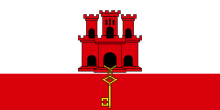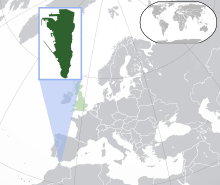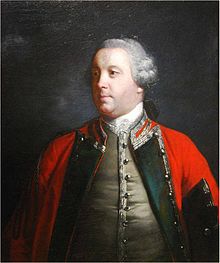The Gibraltar Portal Gibraltar (/dʒɪˈbrɔːltər/ jib-RAWL-tər, Spanish: [xiβɾalˈtaɾ]) is a British Overseas Territory and city located at the southern tip of the Iberian Peninsula, on the Bay of Gibraltar, near the exit of the Mediterranean Sea into the Atlantic Ocean (Strait of Gibraltar). It has an area of 6.8 km2 (2.6 sq mi) and is bordered to the north by Spain (Campo de Gibraltar). The landscape is dominated by the Rock of Gibraltar, at the foot of which is a densely populated town area, home to some 34,003 people, primarily Gibraltarians. Gibraltar was founded as a permanent watchtower by the Almohads in 1160. It switched control between the Nasrids, Castilians and Marinids in the Late Middle Ages, acquiring larger strategic clout upon the destruction of nearby Algeciras c. 1375. It became again part of the Crown of Castile in 1462. In 1704, Anglo-Dutch forces captured Gibraltar from Spain during the War of the Spanish Succession, and it was ceded to Great Britain in perpetuity under the Treaty of Utrecht in 1713. It became an important base for the Royal Navy, particularly during the Napoleonic Wars and World War II, as it controlled the narrow entrance and exit to the Mediterranean Sea, the Strait of Gibraltar, with half the world's seaborne trade passing through it. The sovereignty of Gibraltar is a point of contention in Anglo-Spanish relations as Spain asserts a claim to the territory. Gibraltarians overwhelmingly rejected proposals for Spanish sovereignty in a 1967 referendum, and for shared sovereignty in a 2002 referendum. Nevertheless, Gibraltar maintains close economic and cultural links with Spain, with many Gibraltarians speaking Spanish as well as a local dialect known as Llanito. (Full article...) Selected article -Flat Bastion is a bastion which projects southward from the Charles V Wall in the British Overseas Territory of Gibraltar. Once known as the St. Jago's Bastion or the Baluarte de Santiago in Spanish, the fortification was built by the Spanish in the mid 16th century and formed part of the southern defences of the city of Gibraltar, together with Charles V Wall, Southport Gates, Southport Ditch, and South Bastion. In 1859, six guns, four 12-pounders and two 12-pound carronades, were installed on the bastion, and four years later, five 32-pounders were mounted on the fortification. Flat Bastion takes its name from the angle that its south-facing walls form with each other and with the Charles V Wall. Within the eastern portion of Flat Bastion is Flat Bastion Magazine. The bastion and magazine within it are separately listed with the Gibraltar Heritage Trust. The magazine has been restored and converted into a research facility. (Full article...) Selected picture Photo credit: Gibnews
The West face of the Rock of Gibraltar, a monolithic limestone promontory. It is 426 metres (1,396 feet) high.
Selected quote
SubcategoriesSelected biography -Edward Cornwallis (5 March [O.S. 22 February] 1713 – 14 January 1776) was a British career military officer and member of the aristocratic Cornwallis family, who reached the rank of Lieutenant General. After Cornwallis fought in Scotland, putting down the Jacobite rebellion of 1745, he was appointed Groom of the Chamber for King George II (a position he held for the next 17 years). He was then made Governor of Nova Scotia (1749–1752), one of the colonies in North America, and assigned to establish the new town of Halifax, Nova Scotia. Later Cornwallis returned to London, where he was elected as MP for Westminster and married the niece of Robert Walpole, Great Britain's first Prime Minister. Cornwallis was next appointed as Governor of Gibraltar. Cornwallis arrived in Nova Scotia during a period of conflict with the local indigenous Miꞌkmaq peoples of peninsular Nova Scotia. The Mi'kmaq opposed the founding of Halifax and conducted war raids on the colony. Cornwallis responded with the extirpation proclamation of 1749, orders to bring back scalps of those he considered to be rebels. His administration erected forts at Grand Pre, Chignecto and Halifax and organized a militia of 840 men. Despite these efforts, the conflict would continue for several years after Cornwallis' term. (Full article...) Did you know...
General imagesThe following are images from various Gibraltar-related articles on Wikipedia.
Topics Buildings: The Convent | Dudley Ward Tunnel | Garrison Library | Moorish Castle Communications: .gi | Gibraltar Broadcasting Corporation | Gibraltar Chronicle | Telecom dispute Culture: Cuisine | Gibraltarian people |Gibraltarian status | Languages | Llanito | Music Flora and fauna: Gibraltar Barbary Macaques | Gibraltar candytuft | GONHS | List of birds of Gibraltar | Mammals | List of reptiles and amphibians in Gibraltar | Rock of Gibraltar | The Alameda Gardens History: Battle of Gibraltar | Death on the Rock | Explosion of the RFA Bedenham | George Augustus Eliott, 1st Baron Heathfield | George Rooke | Gibraltar real | Great Siege of Gibraltar | History of the Maltese | History of Nationality | Kingdom of Gibraltar | Military history of Gibraltar during World War II | Moorish Castle | Aurora incident | Pillars of Hercules | Treaty of Utrecht Military: British Forces Gibraltar | Royal Gibraltar Regiment | RAF Gibraltar | HMS Gibraltar | Gibraltar Services Police | Royal Gibraltar Police Symbols: Coat of arms | Flag | Gibraltar Anthem | Other Flags Politics and economy: Chief Minister | Constitution Order (1969, 2006) | Disputed status | Elections | Gibraltar Constitution Order 2006 | Parliament | Gibraltarian pound | Governor | Political parties Religion: Cathedral of St. Mary the Crowned | Cathedral of the Holy Trinity | Great Synagogue | Hinduism | History of the Jews in Gibraltar | Ibrahim-al-Ibrahim Mosque | Methodism | Roman Catholicism | St Andrew's Church Related portalsThings you can doSee alsoAssociated WikimediaThe following Wikimedia Foundation sister projects provide more on this subject:
Discover Wikipedia using portals | ||||||






























































